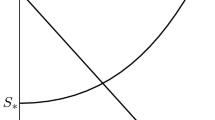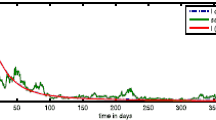Abstract
A general SIRS disease transmission model is formulated under assumptions that the size of the population varies, the incidence rate is nonlinear, and the recovered (removed) class may also be directly reinfected. For a class of incidence functions it is shown that the model has no periodic solutions. By contrast, for a particular incidence function, a combination of analytical and numerical techniques are used to show that (for some parameters) periodic solutions can arise through homoclinic loops or saddle connections and disappear through Hopf bifurcations.
Similar content being viewed by others
References
Busenberg, S., van den Driessche, P.: Analysis of a disease transmission model in a population with varying size. J. Math. Biol. 28, 257–270 (1990)
Busenberg, S., van den Driessche, P. Nonexistence of periodic solutions for a class of epidemiological models. In: Busenberg, S., Martelli, M. (eds.) Biology, Epidemiology, and Ecology. (Lect. Notes Biomath., vol. 92, pp. 70–79) Berlin Heidelberg New York: Springer 1991
Castillo-Chavez, C., Hethcote, H. W., Andreasen, V., Levin, S. A., Liu, W. M.: Epidemiological models with age structure, proportionate mixing, and cross-immunity. J. Math. Biol. 27, 233–258 (1989)
Diekmann, O., Kretzschmar,M.: Patterns in the effects of infectious diseases on population growth. J. Math. Biol. 29, 539–570 (1991)
Doedel, E.: AUTO: Software for Continuation and Bifurcation Problems in Ordinary Differential Equations. California Institute of Technology (1986)
Ermentrout, B.: PhasePlane: The Dynamical System's Tool, Version 3.0. Pacific Grove, CA: Brooks/Cole 1990
Guckenheimer, J., Holmes, P.: Nonlinear Oscillations, Dynamical Systems, and Bifurcations of Vector Fields. Berlin Heidelberg New York: Springer 1983
Hahn, W.: Stability of Motion. Berlin Heidelberg New York: Springer 1967
Hethcote, H. W., Levin S. A.: Periodicity in epidemiological models. In: Levin, S. A., Hallam, T. G., Gross, L. J. (eds.) Applied Mathematical Ecology. (Biomath., vol. 18). Berlin Heidelberg New York: Springer 1989
Jacquez, J. A., Simon, C. P., Koopman, J., Sattenspiel, L., Perry, T.: Modelling and analyzing HIV transmission: the effect of contact patterns. Math. Biosci. 92, 119–199 (1988)
Liu, W.-M., Levin, S. A., Iwasa, Y.: Influence of nonlinear incidence rates upon the behavior of SIRS epidemiological models. J. Math. Biol. 23, 187–204 (1986)
Liu, W.-M., Hethcote, H. W., Levin, S. A.: Dynamical behavior of epidemiological models with nonlinear incidence rates. J. Math. Biol. 25, 359–380 (1987)
Mena-Lorca, J., Hethcote, H. W.: Dynamic models of infectious diseases as regulators of population size. J. Math. Biol. 30, 693–716 (1992)
Nold, A.: Heterogeneity in disease-transmission modeling. Math. Biosci. 52, 227–240 (1980)
Revelle, C., Lynn, W. R., Feldmann, F.: Mathematical models for the economic allocation of tuberculosis control activities in developing nations. Am. Rev. Respir. Dis. 96, 893–909 (1967)
Tudor, D.: A deterministic model for herpes infections in human and animal populations. SIAM Rev. 32, 136–139 (1990)
Westphal, H.: Zur Abschätzung der Lösungen nichlinearer parabolischer Differentialgleichungen. Math. Z. 51, 690–695 (1947/49)
Author information
Authors and Affiliations
Additional information
Supported in part by NSERC grant A-8965, the University of Victoria Committee on Faculty Research & Travel, and the Institute for Mathematics and its Applications, Minneapolis, MN, with funds provided by NSF
Rights and permissions
About this article
Cite this article
Derrick, W.R., van den Driessche, P. A disease transmission model in a nonconstant population. J. Math. Biol. 31, 495–512 (1993). https://doi.org/10.1007/BF00173889
Received:
Revised:
Issue Date:
DOI: https://doi.org/10.1007/BF00173889




